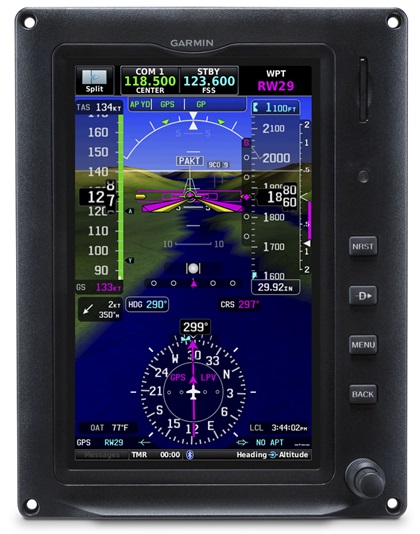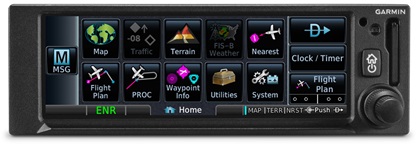Garmin G3X Touch approved for 500 certified singles
Compact touch-screen WAAS navigators also announced
Garmin announced the approval of its G3X Touch flight display for nearly 500 certificated single-engine piston aircraft on March 25 at the Aircraft Electronics Association convention in Palm Springs, California.
The G3X Touch has proved popular with the experimental aircraft community, where it was introduced in March 2014. With several scalable panel configurations, the G3X Touch includes standard wireless connectivity and synthetic vision, as well as optional display redundancy, advanced autopilot compatibility, and engine monitoring. The FAA has already issued supplemental type certificate (STC) approval for the G3X Touch installations.
“Garmin remains committed to offering value-minded solutions that seek to enhance safety in the single-engine piston aircraft market, and the introduction of the G3X Touch flight display for certificated aircraft is yet another example of that commitment,” said Carl Wolf, Garmin vice president of aviation sales and marketing. “We’re excited to bring this game-changing offering to certified piston aircraft owners with ambitions for flight display upgrades that fits their panel—and budget.”
“Many aircraft have not been equipped with WAAS/LPV or ADS-B due to the lack of a compelling value proposition for owners of these aircraft,” Wolf said. “The GPS 175 and GNX 375 offer WAAS/LPV approaches and optional ADS-B In/Out with an impressive array of features, performance, and compelling value.”

The G3X Touch can be configured with a large 10.6-inch display paired with a seven-inch display, providing primary flight display (PFD) and dedicated multifunction display (MFD) capability. Dual seven-inch displays also can serve as dedicated PFDs/MFDs or, where panel space is limited, a single 10.6-inch or seven-inch display can be installed. Multiple displays offer redundancy and reversionary operation, as a single display can show all primary flight information—including optional engine information.
Garmin said the G3X offers an intuitive user interface, controlled through any combination of the touch screen and traditional dual concentric knobs, and that operation is harmonious with multiple Garmin products, including the GTN 650/750 and new GPS 175/GNX 375 navigators. Paired with a G5 electronic flight instrument, launched in March 2016, a G3X Touch display can leverage redundancy benefits of this combination. Garmin’s synthetic vision comes standard on all G3X Touch displays and provides a rich, 3-D depiction of terrain, obstacles, water features, and the runway environment; it also can serve as a standalone VFR navigator with vertical navigation capabilities that allow pilots to generate a vertical descent profile. Garmin Connext allows wireless flight plan transfer and sharing of traffic, weather, and back-up attitude information with a compatible tablet or smartphone.
The G3X Touch can serve as an attitude source for Garmin’s GFC 500 autopilot, in place of the G5 electronic flight instrument. (The G3X Touch for certificated aircraft does not include the integral autopilot capability available in the experimental version of the product.) Installed with a G3X Touch, the GFC 500 provides auto-trim, flight director, airspeed climbs and descents, dedicated level mode, Garmin Electronic Stability and Protection, and underspeed and overspeed protection. The GFC 500 is available as an option for select Beechcraft Bonanza, Cessna 172/182/210, Grumman AA-5, Mooney M20, and Piper PA–28 models, with additional certifications underway.
The G3X Touch can control up to two com radios, including the GNC 255 Nav/Com and the GTR 225 Com, as well as the GTN 650/750. By adding Garmin’s GEA 24, it can display primary engine information.
List prices for the G3X Touch start at $7,995 for a single seven-inch display and $9,995 for a 10.6-inch display, including install kit, GPS antenna, AHRS sensor, and magnetometer; installation labor is additional. Garmin will showcase the G3X Touch flight display in a Grumman AA-5 Tiger at the Sun 'n Fun International Fly-In and Expo in Lakeland, Florida, April 2 through 7. For additional information, see the Garmin website.

The new GPS 175/GNX 375 navigators are designed to easily replace earlier-generation products such as Garmin’s iconic GPS 150/155 series, as well as the GX 50/55 and KLN 89/90/94 series. Aircraft owners can retain many existing flight instruments, audio panels, and legacy CDI/EHSI indicators such as the KI 209—or pair the navigator with a new or existing flight display like the G5 or G3X Touch. They also are compatible with the GFC 500 and GFC 600 autopilots, and select third-party autopilots.
Dedicated pages within the GPS 175 include a moving map, flight plan, nearest, procedures, waypoint information, and terrain pages; the GNX 375 adds ADS-B traffic and weather pages. The touch screens on both units allow graphical flight plan editing. FastFind applies predictive logic to suggest airports and waypoints based on current GPS location, and Smart Airspace simplifies identification of pertinent airspace on the moving map. SafeTaxi airport diagrams show the aircraft’s location on the surface relative to runways, taxiways, fixed-base operations, and ramps.

Built-in Connext capability allows wireless flight plan transfer via Bluetooth to and from compatible portables and mobile devices running the Garmin Pilot or FltPlan Go apps. The GNX 375’s integrated ADS-B allows pilots to view ADS-B traffic and weather on compatible devices.
The GPS 175 and GNX 375 are scheduled to be available from Garmin dealers in April with list prices starting at $4,995 and $7,995, respectively. A free Garmin GPS 175/GNX 375 trainer app can be downloaded to Apple mobile devices, allowing customers to explore these navigators’ feature sets. For more information on the GPS 175/GNX 375, see the Garmin website.




